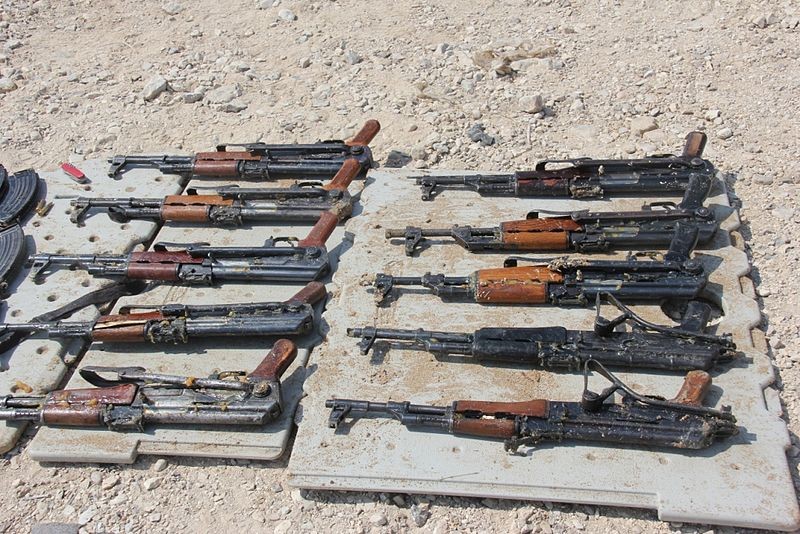Tracking crime guns is way to catch traffickers, says head of new gun crime centre
Date 4.02.2018

Many European countries are missing their chance to tackle gun smuggling by ignoring the origin of weapons recovered from crime scenes, the head of the University’s new research centre into firearms crime has warned.
According to recent ONS figures, gun crime in England and Wales rose by 20% last year, and Dr Helen Poole, whose research focuses on firearm trafficking through Europe, said solving individual firearm cases wasn’t enough to combat the rise in gun smuggling being facilitated by post-conflict states and the dark web.
Dr Poole said: “All too often officers will seize one firearm, identify the suspect, and then close the case. However, such an approach risks losing valuable intelligence in terms of where that gun came from, where else it might have been used, and the uncovering of trafficking routes.”
Tracking just one firearm can potentially lead to the recovery of illegal consignments and the capture of the smugglers, she added.
Dr Poole made the comments ahead of the launch of the new Centre for The Reduction of Firearms Crime, Trafficking and Terrorism, which will be the first research centre of its type in the UK.
Some of the world’s top firearms experts will be present for the launch, including representatives from academia, The Metropolitan Police, Interpol, the United Nations Office on Drugs and Crime, as well as the UN Security Council Sanctions Committee.
The new University of Northampton initiative aims to create a worldwide network of experts in order to address the challenges – brought about by global differences in firearms culture and legislation and the variable intelligence picture available in different countries – that currently hampers international co-operation over gun crime.
Dr Poole said: “In order to tackle the threat from firearms it is important that policy makers, law enforcement agencies and intelligence services work together to not only seize illegal firearms, but also use all possible intelligence from these weapons to identify the routes and criminals that brought them onto the streets.”
Tracing a weapon’s journey is too often seen as merely creating more work, she said, but solving the crime shouldn’t be viewed as the end of the story.
“Following the gun is more likely to reduce the number of future victims, and the serious harm caused to families and communities as a result of the number of crime guns in circulation.”
According to Dr Poole, advances in ballistics comparison technology, such as that used by the International Ballistics Intelligence Network, now made it possible to compare ballistics intelligence to match different crime scenes and, when combined with other forms of evidence and intelligence, to identify who is behind the supply of weapons.
“However, this requires cooperation between nations to share information quickly, facilitated in many cases by international policing organisations such as Europol and Interpol, as well as a change in the mindset of detectives,” added Dr Poole.
The London Assembly Police and Crime Committee recently warned that the supply of guns into the UK from abroad is a growing concern, with an increasing number of weapons originating from Eastern Europe, particularly de-commissioned guns, which are easily converted.
The movement of weapons across European borders has been evidenced in various terrorist investigations, including the 2015 Paris attacks when 130 people died.
The apprehension of the so-called Shilling gang following a National Crime Agency operation in August 2015 demonstrated how the UK is not immune to such threats. In this case, 22 Czech VZ58 rifles and 9 Scorpion sub-machine guns, as well as 1500 rounds of ammunition, were intercepted at Cuxton Marina, Kent, having been smuggled through Europe from Slovakia.
The conviction in Birmingham last November of Paul Edmunds, for importing and supplying illegal weapons and ammunition from the US is further, more recent, evidence of the problem.
“Tackling armed violence is complex, with challenges presented by stockpiles of weapons in post-conflict regions, the opportunities for criminal traffickers provided by modern technology and the dark web, the complexity of international arms trafficking, inconsistent firearms legislation between states, and corruption,” said Dr Poole.
Dr Helen Poole leads the Centre for The Reduction of Firearms Crime, Trafficking and Terrorism which is housed within the University of Northampton’s Institute of Public Safety, Crime and Justice.
1) There was a reported increase in firearms related crimes in the UK last year, up 20% across the UK in the year till September 2017 as compared to the previous year, with police in England and Wales recording 6,694 offences (Office for National Statistics, January 2018).
2) In the last three years, the number of gun offences in London has risen. In the 12 months to October 2017, there were 2,500 offences involving guns: a 16 per cent increase on the previous year and a 44 per cent increase on 2014 (London Assembly Police and Crime Committee, January 2018).
3) From 2012-2016, there was an estimated 1.04 million firearm related deaths worldwide (data from the Small Arms Survey).
4) The human cost of firearms crime committed by both illicit and legally held firearms is enormous, with an estimated 210,000 incidents where firearms were used to kill in 2016, equating to 38% of all lethal violence incidents globally. Over 80% of these were homicides, with a relatively small percentage as a result of conflict.